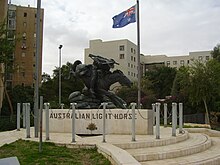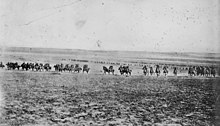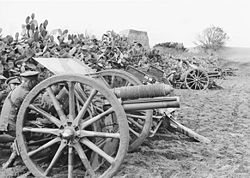4th Light Horse Brigade
| 4th Light Horse Brigade | |
|---|---|
 Australian Light Horse monument at Beersheba | |
| Active | 1915–1918 |
| Country | |
| Allegiance | British Empire |
| Branch | Australian Army |
| Type | Mounted Rifles |
| Size | Cavalry Brigade |
| Part of | 4th Australian Contingent, 1914–15 New Zealand and Australian Division, 1915–16 Egyptian Expeditionary Force Imperial Camel Corps, 1916–17 Imperial Mounted Division, 1917 Australian Mounted Division, 1917–19. |
| Equipment | Horse, Sword in 1918 |
| Engagements | Gallipoli Campaign Sinai and Palestine Campaign
|
| Insignia | |
| Unit colour patch | |
The 4th Light Horse Brigade was a mounted infantry brigade of the First Australian Imperial Force serving in the Middle Eastern theatre of World War I. The brigade was formed in March 1915 and shipped to Egypt without their horses and was broken up in Egypt in August 1915. Reformed in February 1917, the Brigade was attached to the Imperial Mounted Division of the Egyptian Expeditionary Force and in June 1917 transferred to the Australian Mounted Division, where it served in the Sinai and Palestine Campaign until the end of the war.
Contents
1 History
1.1 Formation
1.2 Embarkation
1.3 Reformation
1.4 Battle of Beersheba
1.5 Disbandment
2 Composition
2.1 4th Light Horse Regiment
2.2 11th Light Horse Regiment
2.3 12th Light Horse Regiment
2.4 4th Light Horse Machine Gun Squadron
2.5 4th Light Horse Signal Troop
2.6 4th Light Horse Field Ambulance
2.7 4th Light Horse Brigade Train
2.8 9th Mobile Veterinary Section
2.9 Artillery
2.10 4th Light Horse Training Regiment
3 Commanders
4 Campaigns
5 See also
6 References
7 External links
History
Formation

Middle Eastern Theatre during World War I
The 4th Light Horse Brigade was raised in response to a promise made by the Australian Government to supply a division of 20,000 Australians comprising infantry, artillery and cavalry to be used at the discretion of Britain. The 4th Light Horse Brigade was part of the 4th Contingent that was raised from 4 March 1915. The 4th Light Horse Brigade was primarily raised from recruits currently serving in the various militia light horse formations created as a consequence of the Kitchener Report 1910 and the introduction of Universal Training.
Embarkation
The original Brigade embarked to Egypt during months of May and June 1915. In Egypt additional training occurred at the Heliopolis Camp. Subsequent embarkations of reinforcements occurred as and when sufficient recruits were gathered and prepared for movement to a war theatre.[1]
Reformation
After returning to Egypt from the Gallipoli Campaign the 4th, 11th and 12th Light Horse Regiments remained unbrigaded until the War Office agreed to reform the 4th Light Horse Brigade in January 1917. The brigade would join the 3rd Light Horse Brigade and the 5th and 6th Mounted Brigades to form the Imperial Mounted Division (later known as the Australian Mounted Division).[2]
Battle of Beersheba

Photograph taken in early February 1918 of a re-enactment of the charge of the 4th Light Horse Brigade at Beersheba
The most notable action the 4th Light Horse Brigade participated in was the mounted infantry charge during the Battle of Beersheba on October 31, 1917.
Disbandment
The Brigade was disbanded in July 1919 when the individual regiments returned to Australia from June to July 1919. As each Regiment arrived in the specific home port, they were disbanded.
Composition
4th Light Horse Regiment
This Regiment was recruited exclusively Victoria in August 1914 as Divisional Cavalry. "B" and "D" Squadrons embarked for France in May 1916. A new "B" Squadron was raised as a consequence. The Regiment was renamed 3rd Camel Regiment in September 1916 and served with the Imperial Camel Corps until it brigaded with the 11th and 12th Light Horse Regiments into the 4th Light Horse Brigade in February 1917.[3]
11th Light Horse Regiment
This was a composite Regiment recruited primarily from Queensland with a South Australian Squadron. "A" Squadron and "B" Squadron recruited from Queensland and "C" Squadron recruited from South Australia. The Regiment was broken up on 26 August 1915 as reinforcements to Regiments at Gallipoli. "A" Squadron became "D" Squadron, 2nd Light Horse Regiment, "B" Squadron became "D" Squadron, 5th Light Horse Regiment and"C" Squadron became "D" Squadron, 9th Light Horse Regiment. The Regiment was reconstituted on 20 February 1916 at Heliopolis, Egypt. The Regiment was renamed 1st Camel Regiment in September 1916 and served with the Imperial Camel Corps until it brigaded with the 4th Light Horse Brigade in February 1917.[4]
12th Light Horse Regiment
The 12th Light Horse Regiment was recruited exclusively from New South Wales. The Regiment was broken up on 26 August 1915 as reinforcements to Regiments at Gallipoli. "A" Squadron became "D" Squadron, 1st Light Horse Regiment, "B" Squadron became "D" Squadron, 7th Light Horse Regiment and "C" Squadron became "D" Squadron, 6th Light Horse Regiment. The Regiment was reconstituted on 20 February 1916 in Egypt. It was renamed 2nd Camel Regiment in September 1916 and served with the Imperial Camel Corps until it brigaded with the 4th Light Horse Brigade in February 1917.[5]
4th Light Horse Machine Gun Squadron
The 4th Light Horse Machine Gun Squadron was formed when the Parent Brigade was formed in February 1917. The 4th Light Horse Machine Gun Squadron was armed with 12 machine-guns.[6]
4th Light Horse Signal Troop
The 4th Signal Troop was created in February 1917 by drafting in four signallers from each of the 12 Regiments in Palestine.[6]
4th Light Horse Field Ambulance
The 4th Light Horse Field Ambulance was formed in February 1917 from some 60 men drawn out of all the other Light Horse formations in Egypt.[6]
4th Light Horse Brigade Train
The 4th Light Horse Brigade Train was primarily recruited around Melbourne and trained at Broadmeadows. After Gallipoli, this unit underwent some name changes from 4th Supply Section in February 1917 to 36th Australian Army Service Corps Company in August 1917.[6]
9th Mobile Veterinary Section
The 9th Mobile Veterinary Section was formed in February 1917.[6]
Artillery

Gunners of A Battery, Honourable Artillery Company, attached to the 4th Australian Light Horse Brigade, crouch between their 13 pounder quick fire field guns and a cactus hedge near Belah, Palestine, in March 1918.
Artillery support was provided for the 4th Light Horse Brigade by the British A Battery, Honourable Artillery Company of XIX Brigade, Royal Horse Artillery (T.F.).[6]
4th Light Horse Training Regiment
Formed in Egypt during February 1917, this unit trained incoming reinforcements while allowing the wounded and sick a place to recover before returning to active service. The Training Regiment contained three squadrons, each duplicating the Regiments within the Brigade to whom it supplied the reinforcements. The Training Regiment was disbanded in July 1918 to be replaced by the Australian Light Horse Training Regiment when recruits were no longer tied to a Regiment but placed in a general pool of reinforcements called the General Service Reinforcements.[6]
Commanders
- Brigadier General John Baldwin Meredith (13 February 1917 – 13 September 1917)
- Brigadier General William Grant (13 September 1917 – June 1919)[6]
Campaigns
Palestine:
- First Battle of Gaza
- Second Battle of Gaza
- Third Battle of Gaza
- Battle of Beersheba
- Battle of Jerusalem
- Es Salt
- Battle of Megiddo (1918)
- Damascus.
See also
- 1st Light Horse Brigade
- 2nd Light Horse Brigade
- 3rd Light Horse Brigade
- 5th Light Horse Brigade
References
^ See: Troop transport ships for information and photographs about the various ships employed in transporting the troops to Egypt.
^ * Falls, Cyril; G. MacMunn (1930). Military Operations Egypt & Palestine from the outbreak of war with Germany to June 1917. Official History of the Great War Based on Official Documents by Direction of the Historical Section of the Committee of Imperial Defence. 1. London: HM Stationery Office. OCLC 610273484..mw-parser-output cite.citation{font-style:inherit}.mw-parser-output q{quotes:"""""""'""'"}.mw-parser-output code.cs1-code{color:inherit;background:inherit;border:inherit;padding:inherit}.mw-parser-output .cs1-lock-free a{background:url("//upload.wikimedia.org/wikipedia/commons/thumb/6/65/Lock-green.svg/9px-Lock-green.svg.png")no-repeat;background-position:right .1em center}.mw-parser-output .cs1-lock-limited a,.mw-parser-output .cs1-lock-registration a{background:url("//upload.wikimedia.org/wikipedia/commons/thumb/d/d6/Lock-gray-alt-2.svg/9px-Lock-gray-alt-2.svg.png")no-repeat;background-position:right .1em center}.mw-parser-output .cs1-lock-subscription a{background:url("//upload.wikimedia.org/wikipedia/commons/thumb/a/aa/Lock-red-alt-2.svg/9px-Lock-red-alt-2.svg.png")no-repeat;background-position:right .1em center}.mw-parser-output .cs1-subscription,.mw-parser-output .cs1-registration{color:#555}.mw-parser-output .cs1-subscription span,.mw-parser-output .cs1-registration span{border-bottom:1px dotted;cursor:help}.mw-parser-output .cs1-hidden-error{display:none;font-size:100%}.mw-parser-output .cs1-visible-error{font-size:100%}.mw-parser-output .cs1-subscription,.mw-parser-output .cs1-registration,.mw-parser-output .cs1-format{font-size:95%}.mw-parser-output .cs1-kern-left,.mw-parser-output .cs1-kern-wl-left{padding-left:0.2em}.mw-parser-output .cs1-kern-right,.mw-parser-output .cs1-kern-wl-right{padding-right:0.2em} pp. 273–4
^ "4th Australian Light Horse Regiment". Australian Light Horse Studies Centre. Retrieved 2009-04-19.
^ "11th Australian Light Horse Regiment". Australian Light Horse Studies Centre. Retrieved 2009-04-19.
^ "12th Australian Light Horse Regiment". Australian Light Horse Studies Centre. Retrieved 2009-04-19.
^ abcdefgh "4th Australian Light Horse Brigade". Australian Light Horse Studies Centre. Retrieved 2009-04-19.
External links
Australian Light Horse Studies Centre 4th Australian Light Horse Brigade
- Australian National Archives – Kitchener Report, 1910
